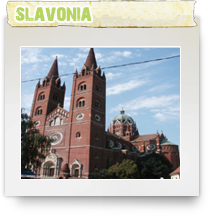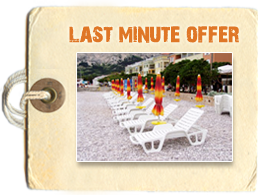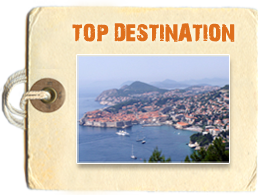 Croatia - History
Croatia - History
Slavonia is Croatian region located on the very north-east of Croatia. It cover the area between River Sava and Drava and borders with river Danube (Dunav) on the East. Slavonia is a flat and fertile area so it's important source of food fro whole of Croatia. Slavonia is also known for it's Djakovo Lipicaner Horse Breed, that is bred in Djakovo for centuries.
Djakovo, a town in the region of Slavonia, 37 km to the southwest of Osijek and 34 km southeast of Nasice; elevation 111 m. The centre of the fertile and rich Dakovo region (Dakovstina). Chief occupations include farming, livestock breeding, leather and wool processing; horse selection centre; major industries are wood processing (furniture), textiles, chemicals and food processing, building material, printing and tourism. Dakovo is located at the intersection of the main road (M17.01, E 73) Osijek Dakovo and the regional road Nasice Dakovo and the railroad Vrpolje Osijek.
Virovitica is a Croatian city near the Croatian-Hungarian border. It is situated near the Drava river and belongs to the historic region of Slavonia. Virovitica has a population of 15,589, with 22,618 people in the municipality (census 2001). It is also the capital of the Virovitica-Podravina county.
Virovitica has also historically been known by the names Wirowititz/Virovititz and Wirowitiza (German), Viroviticza, Verewitiza, Verowitiza, Verowtiza, Verőce (Hungarian) and Varaviza (Italian).
Vinkovci, is a Croatian town in eastern Slavonia, with a population of 32,4505-Jul-2012 12:21 PMsolute majority of its citizens are Croats with 88.99% (2001 census).
Vinkovci is located on the bank of the Bosut river, 19 km southwest of Vukovar, 24 km north of Županja and 43 km south of Osijek; elevation 90 m.
The town features extremely rich cultural and historical heritage, the most interesting attraction being the pre-Romanesque church on Meraja from 1100, with the coats of arms of the kings Koloman and Ladislas, as one of the most important medieval cultural monuments in Croatia.
The most famous annual event, one of the biggest in Slavonia, is the folk music festival "Vinkovci Autumns" (Vinkovačke Jeseni), which includes the folklore show and the presentation of folk customs of Slavonia. It is characterized by a number of original folk music performances, beautiful traditional costumes, a beauty contest, competitions of the manufacturers of kulen (smoked paprika-flavoured sausage), plum brandy and other traditional foodstuffs, and especially by the magnificent closing parade.
Vinkovci's music school Josip Runjanin is named after the composer of the Croatian national anthem Lijepa nasa domovino. The Vinkovci gymnasium is named after Matija Antun Reljković, a Slavonian writer who lived in the city in the 18th century.
Vukovar, is a city and municipality in eastern Croatia, and the biggest river port in Croatia located at the confluence of the Vuka river into the Danube. Vukovar is the center of the Vukovar-Srijem county. The city's registered population was 30,126 in the 2001 census, up to 31,670 in the municipality.
It is located 20 km east of Vinkovci, 36 km southeast of Osijek with the elevation of 108 m. Vukovar is located on the main road (M7) Osijek—Vukovar—Ilok and on the Vinkovci—Vukovar railway.
Among a number of attractive buildings, severely damaged in the recent war, the most interesting are the Eltz Manor of the Eltz noble family from 18th century, Baroque buildings in the centre of the town, the Franciscan monastery, the parish church of St. James, the Orthodox church of St. Nicholas, the birth house of the Nobel prize winner Lavoslav Ružička, etc. Since 1998 and peaceful reintegration under Croatian control, many buildings have been rebuilt, but there are many ruins still in the town.
Outside the town, on the banks of the Danube toward Ilok, lies a notable archaeological site, Vučedol. The ritual vessel called the Vučedol Dove (vučedolska golubica) is considered the symbol of Vukovar. Vučedol is also a well-known excursion destination, frequented by anglers and bathers, especially the beautiful sand beach on Orlov Otok (Eagle's Island).
Sports and recreational opportunities are provided at the attractive confluence of the Vuka river into the Danube, on the promenades along the Danube and maintained beaches. Bathing is possible in the summer months. Angling is very popular both on the Vuka and the Danube (catfish, European perch, carp, pike, sterlet).
Osijek, is the fourth largest city in Croatia with a population of 114,616 in 2001.
It is the largest city and the economic and cultural centre of Slavonia (eastern Croatia), as well as the administrative center of the Osijek-Baranja county.
Osijek is located on the right bank of the river Drava, 25 km upstream of its confluence with the Danube, at an elevation of 94 m. Transportation links include major railway and highway junctions, a river port, and a regional airport. A full motorway, linking the important city to the rest of the Croatian Motorway network and the major Pan-European corridor 5c, is well under construction and will reach Osijek by 2008.
The name was given to the city due to its place on the elevated ground which prevented the city being flooded by the local swamp waters. Its name Osijek comes from the word "oseka" which means "ebb tide" and was referred to the place where it is ebb tide and was suitable for settlement.
Due to its past and its history within Habsburg Monarchy and briefly in the Ottoman Empire and also due to the presence of German and Hungarian minorities throughout its history, Osijek also has (or had) its name versions in other languages, Hungarian: Eszék, German: Esseg, Latin: Essec, Turkish: Ösek. All those names were adjusted variations to the original Croatian given name. In Roman times Osijek was called Mursa.
Osijek remains a popular domestic tourist destination for its Baroque style, open spaces and ample recreational opportunities. The most important sights in the city include the main square, Trg Ante Starčevića, Tvrđa the 18th century Baroque citadel, the promenade along the Drava ("promenada"), and the suspension pedestrian bridge toward Baranja.
The Municipal Park of King Petar Krešimir IV and the Tomislav Park date from the beginning of the 20th century, and are protected national landmarks. Osijek is also home to one of the few Croatian zoological gardens, along the Drava river.
Numerous events take place in the city throughout the year. The most important of them are the Croatian Tambura Music Festival (in May), attended by tambura orchestras from all over Croatia and the Osijek Summer Nights (during June, July and August), a series of cultural and entertainment programs in the open, accompanied by excellent food and fairs. The Day of the City of Osijek is celebrated with a cultural and artistic activities and exhibitions.
The recreational and sports centre Copacabana, located on the left bank of the Drava river, provides opportunities for various water sports (outdoor swimming pools and a sand beach with various facilities) during the summer months. The city offers various playgrounds: football, handball, basketball, tennis courts, etc.
Football club NK Osijek is playing in Croatian First League at Gradski vrt stadium.





